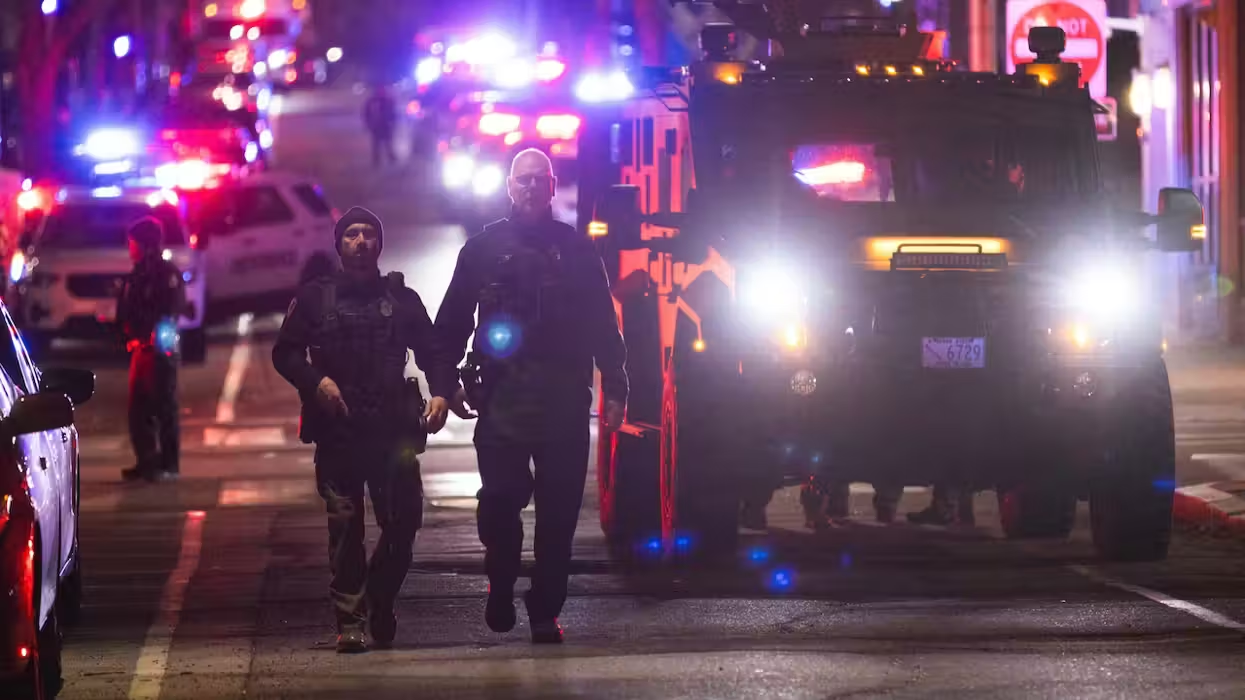You may not have heard the terms ISIS, ISIL, the Islamic State or caliphate in the mainstream media until this summer, but that doesn’t mean the violent Islamic jihadist organization is a completely new entity.
A Salafi-jihadi by any other name still beheads their victims.
 TheBlaze TV's For the Record spoke to counterterrorism experts who said the Islamic State beheaded American journalist James Foley in part as a commitment to its Salafi-jihadist end goals, the underlying ideology that bonds dozens of terror groups across the region. (AP)
TheBlaze TV's For the Record spoke to counterterrorism experts who said the Islamic State beheaded American journalist James Foley in part as a commitment to its Salafi-jihadist end goals, the underlying ideology that bonds dozens of terror groups across the region. (AP)
The headline-grabbing introduction of the Islamic State in the last several months was a calculated rebranding by the Al Qaeda offshoot, with its specific, deadly strain of Islamic ideology dubbed Salafist jihadism. This ultra-strict ideology suggests the Koran must be followed word-for-word and may not be interpreted by anyone else. Rather than the violent uprising of a new breed of terrorist, the Islamic State is simply embracing the strictest ideology associated with the first three decades of Islam.
This is the ideology that connects all terror groups — the Islamic State and Al Qaeda alike — and it's the brutal mindset they hope to impress upon the hearts of jihadi sympathizers susceptible to radicalization.
It’s an important connection to grasp, since President Barack Obama declared on multiple occasions that “Al Qaeda is on the run and Osama bin Laden is dead,” indicating the primary Al Qaeda threat to the U.S. — the ability to attack the United States within its borders — was removed. But one former federal prosecutor says the commander in chief downplayed the enemy in his descriptions, creating a gap in understanding about the Al Qaeda-spawned organizations that have actually increased in number by 58 percent since 2010.
“What the Obama administration in particular has done ... since the president took office in 2009, in claiming to have decimated Al Qaeda, in claiming to have rolled back the terrorist threat, in claiming that we are a safer place than we were before he took office, has been a real purposeful attempt to miniaturize the enemy,” said Andrew McCarthy, who led the prosecution of the "Blind Sheik," Omar Abdel Rahman, for the 1993 World Trade Center bombing. McCarthy spoke to TheBlaze TV's For the Record for Wednesday's new episode, "Total Confrontation" (8 p.m. ET).
That might be the one thing the Islamic State and the Obama administration have in common: They’ve both attempted to minimize Al Qaeda, but for very different reasons. Obama thinks Al Qaeda is “decimated”; Abu Bakr al-Baghdadi, the current leader of the Islamic State, thinks Al Qaeda moves too slowly.
In this way, the Islamic State likely sees Al Qaeda as its unwelcome anchor rather than as a supporting parent organization. But the two organizations are inextricably linked, even though the Islamic State is attempting to prove daily that it is willing and able to take its tactics in more brutal directions, and is pushing a more aggressive timeline for a full establishment of a caliphate.
Al-Baghdadi’s calculated rebranding of his terror branch this year — first as the Islamic State of Iraq and the Levant before the condensed "Islamic State" — is a purposeful honing of that vision and message.
“IS was formerly constituted as Al Qaeda in Iraq, but was disowned by 'core' al Qaeda leader Ayman al Zawahiri in February 2014. This fracture resulted in all-out war between the two groups for the leadership of the international jihad movement,” said Brian Fairchild, a former CIA operations officer. “Some describe it as Al Qaeda 6.0."
The significant differences between Al Qaeda and the Islamic State could almost be seen as an upgrade for millennial jihadis: they embrace a newer, social-media friendly recruiting pattern and a penchant for self-promotion while focused on immediate results.
But the most important connection between the younger-seeming Islamic State and old-school Al Qaeda is the identifier the Obama administration has vehemently suppressed, both in narrative and in function: the underlying Salafi-jihadist ideology.
“The game-changing rise of the Islamic State and the phenomenal flood of radicalized foreign fighters flowing to the new 'caliphate' make political correctness and willful ignorance … of the jihad a recipe for national disaster,” Fairchild wrote in an analysis post on his website.
This means several organizations with different names and leadership charisma remain linked by their underlying mission and jihadist vision. Core Al Qaeda in Pakistan; formal affiliates that have sworn allegiance to core Al Qaeda (located in Syria, Somalia, Yemen and North Africa); the panoply of Salafi-jihadist groups that have not sworn allegiance to Al Qaeda; and inspired individuals and networks all have their own terrifying tactics — the common bond between these various terror networks is their relentless commitment to establishing an extremist Islamic emirate and returning Islam to its purest form.
 The Islamic State group is often described as the most fearsome jihadi outfit of all: a global menace outweighing Al Qaeda, but experts interviewed by For the Record argue it's the underlying Salafi-jihad mindset that fuels the brutal group, and this mindset is the foundational connection between multiple terror networks. (AP Photo/Militant Website, File)
The Islamic State group is often described as the most fearsome jihadi outfit of all: a global menace outweighing Al Qaeda, but experts interviewed by For the Record argue it's the underlying Salafi-jihad mindset that fuels the brutal group, and this mindset is the foundational connection between multiple terror networks. (AP Photo/Militant Website, File)
“Government recognition of the Islamic religious foundation of jihad is essential for two specific national security reasons. The Muslim dilemma can never be successfully addressed until this fact is acknowledged, and official recognition of the religious nature of jihad would provide American counterterrorism officers with an investigative direction,” Fairchild wrote.
The ongoing feud between the Islamic State and Al Qaeda has only added to the confusion for average citizens trying to understand the connections between the violent groups.
Fairchild said the rivalry between the Salafi-jihadist organizations boils down to a single point: it means more violence will be directed at anyone who disagrees with a strict interpretation of the Koran.
Some experts say the Islamic State’s intense, regional focus to push for the caliphate proves the group is less a threat to the United States than core Al Qaeda, but as experts told For the Record, the end goal of all the Salafi-jihadist organizations remains the same: convert or kill.
“I don’t pretend that ISIS doesn’t see itself now as different from some of the other Al Qaeda groups, but an awful lot of the labeling that’s gone on has been the West trying to miniaturize Al Qaeda into a bunch of little regional and parochial branches that don’t really glue together because then you'd have to acknowledge the ideology that does bring all the stuff together,” McCarthy said, “and more of that has been labeling by us than self-identification by the jihad.”
Fairchild put it bluntly: It doesn’t matter how the U.S. classifies the Islamic State or other Al Qaeda affiliates; if a terror network self-identifies as Salafi-jihadist, they are embracing literal interpretation of the Koran's commands to wipe out both Muslim “apostates” who disagree with violent jihad tactics, and nonbelievers in other countries.
No matter how the West defines the groups, Fairchild notes, if ideology that links them is ignored or minimized, intelligence groups have missed the point.
“And the enemy always gets a vote,” he said.
—
Follow Elizabeth Kreft (@elizabethakreft) on Twitter

 TheBlaze TV's For the Record spoke to counterterrorism experts who said the Islamic State beheaded American journalist James Foley in part as a commitment to its Salafi-jihadist end goals, the underlying ideology that bonds dozens of terror groups across the region. (AP)
TheBlaze TV's For the Record spoke to counterterrorism experts who said the Islamic State beheaded American journalist James Foley in part as a commitment to its Salafi-jihadist end goals, the underlying ideology that bonds dozens of terror groups across the region. (AP)






